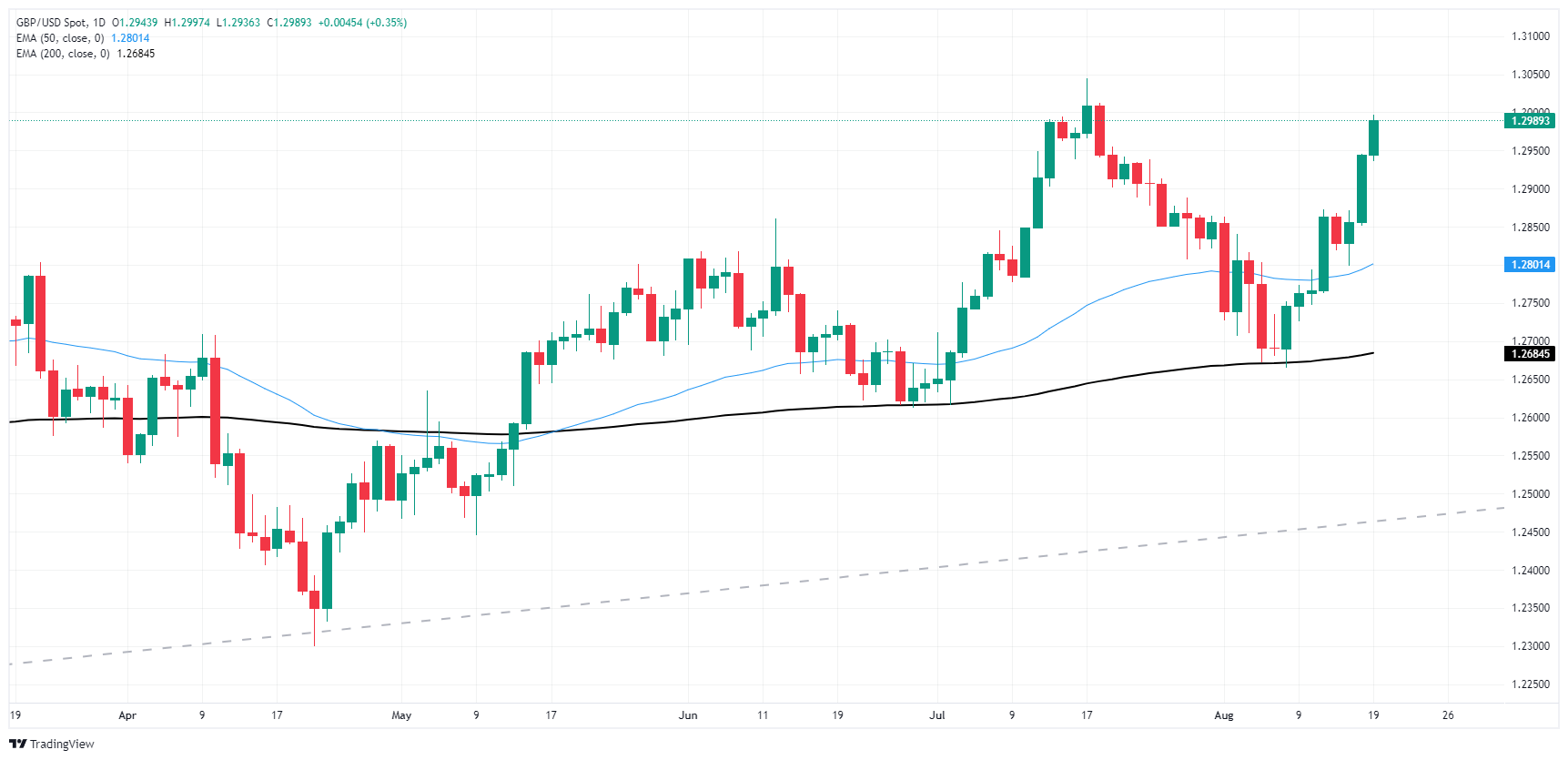GBP/USD climbs for a third straight day as Greenback recedes
- GBP/USD fell just shy of reclaiming the 1.3000 handle on Monday.
- UK and US PMIs slated for Thursday this week.
- Jackson Hole Economic Symposium kickoff looms ahead.
GBP/USD rose one-third of one percent after the US Dollar continued to recede to kick off the new trading week. Greenback flows extended a near-term course reversal as investors shrug off a recent downswing in market sentiment. A rough patch of bad US data reignited investor fears of an impending US recession, but a late upswing in recent US data prints have soothed investor nerves, who have to returned to waiting for signs of rate cuts from the Federal Reserve (Fed).
Forex Today: Attention shifts to Fedspeak ahead of Jackson Hole
The midweek stretch is a quiet affair as markets await key data on Thursday as well as the kickoff of this year’s Jackson Hole Economic Symposium. All three are expected to land on markets beginning on Thursday.
UK Purchasing Managers Index (PMI) figures are expected to hold on the high side in August. UK MoM Manufacturing PMI numbers are expected to hold steady at 52.1, while the Services PMI component is forecast to tick upwards to 52.8 from 52.5 over the same period.
Across the Atlantic, US PMI figures are expected to soften on Thursday. US Manufacturing PMI in August is expected to tick down slightly to 49.5 from 49.6, while US Services PMI numbers are forecast to fall an entire point to 54.0 from 55.0.
The Jackson Hole Economic Symposium, slated to kick off a multi-day central banker extravaganza on Thursday, will have investors across the globe tuning in for any signals from Fed policymakers about the likelihood of a Fed rate cut in September.
Recent bets of a double cut in September have eased significantly after reaching a peak of 70% two weeks ago. According to the CME’s FedWatch Tool, rate markets are pricing in a scant one-in-five chance of a 50 bps cut on September 18. Overall, markets still have a 25 bps cut in September fully priced in, with three or four quarter-point cuts expected by the end of the year.
GBP/USD price forecast
Despite a firm extension of bullish momentum on Monday, GBP/USD bidders were unable to recapture the 1.3000 major price handle, hanging price action out to dry at key resistance levels on the tail end of a one-sided momentum play. Near-term momentum traders will be looking for an opportunity to jump short, targeting a decline back into the 50-day Exponential Moving Average (EMA) near 1.2800.
GBP/USD daily chart
Pound Sterling FAQs
The Pound Sterling (GBP) is the oldest currency in the world (886 AD) and the official currency of the United Kingdom. It is the fourth most traded unit for foreign exchange (FX) in the world, accounting for 12% of all transactions, averaging $630 billion a day, according to 2022 data. Its key trading pairs are GBP/USD, aka ‘Cable’, which accounts for 11% of FX, GBP/JPY, or the ‘Dragon’ as it is known by traders (3%), and EUR/GBP (2%). The Pound Sterling is issued by the Bank of England (BoE).
The single most important factor influencing the value of the Pound Sterling is monetary policy decided by the Bank of England. The BoE bases its decisions on whether it has achieved its primary goal of “price stability” – a steady inflation rate of around 2%. Its primary tool for achieving this is the adjustment of interest rates. When inflation is too high, the BoE will try to rein it in by raising interest rates, making it more expensive for people and businesses to access credit. This is generally positive for GBP, as higher interest rates make the UK a more attractive place for global investors to park their money. When inflation falls too low it is a sign economic growth is slowing. In this scenario, the BoE will consider lowering interest rates to cheapen credit so businesses will borrow more to invest in growth-generating projects.
Data releases gauge the health of the economy and can impact the value of the Pound Sterling. Indicators such as GDP, Manufacturing and Services PMIs, and employment can all influence the direction of the GBP. A strong economy is good for Sterling. Not only does it attract more foreign investment but it may encourage the BoE to put up interest rates, which will directly strengthen GBP. Otherwise, if economic data is weak, the Pound Sterling is likely to fall.
Another significant data release for the Pound Sterling is the Trade Balance. This indicator measures the difference between what a country earns from its exports and what it spends on imports over a given period. If a country produces highly sought-after exports, its currency will benefit purely from the extra demand created from foreign buyers seeking to purchase these goods. Therefore, a positive net Trade Balance strengthens a currency and vice versa for a negative balance.